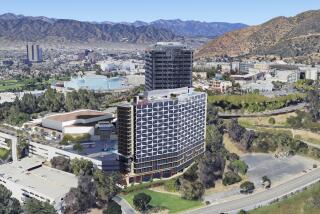Limits on LAX Growth OKd
A local government organization that oversees regional growth gave final approval Thursday to a transportation plan that would limit growth at Los Angeles International Airport and encourage expansion of other Southern California airports.
The vote by the Southern California Assn. of Governments, which is composed of more than 40 city council members and county supervisors from six counties, was a setback to Los Angeles airport officials, who want to significantly expand service at LAX.
But Jim Ritchie, deputy director of long-range planning for LAX, said in a written statement that the “action will have no impact whatsoever” on the current $12-billion plan to expand the airport.
The agency took its 38-2 vote at the conclusion of a two-hour public hearing attended mostly by opponents of LAX expansion. Most were residents of Inglewood, who argued that they should not have to contend with more noise, air pollution and traffic from a bigger LAX.
In a move that surprised many observers, the planning board granted a request by airport opponents to exclude from the transportation plan a new offramp to the airport from the San Diego Freeway at Arbor Vitae Street.
The city of Los Angeles and Caltrans view the $55-million Arbor Vitae project as critical to efforts to relieve traffic congestion at the airport.
Opponents believe that if they block the freeway project it will throw the LAX master plan out of compliance with clean air laws.
“We are ecstatic,” said Mike Stevens, who brought a busload of Inglewood residents to the meeting. “Without Arbor Vitae they cannot mitigate traffic and without mitigating traffic, they can’t expand.”
City transportation planners said there is still a good chance the freeway project can be built because approvals and financing have already been lined up. But they were dismayed that the project, in the planning stages for 14 years, got caught up in the fight over LAX expansion.
“It would do a lot of good toward relieving existing traffic problems with the airport,” said Allyn Rifkin, of the Los Angeles Department of Transportation.
The aviation plan was only one part of a massive document outlining support for a variety of transportation projects, from construction of carpool lanes on freeways and bicycle lanes on streets to expansion of public transit.
Federal law requires that all transportation plans be part of a regional planning process. If a project is not adopted by the Southern California Assn. of Governments, it may not qualify for state or federal funds.
Although a variety of street and rail projects were in the plan, airports dominated Thursday’s debate.
The plan approved Thursday seeks to limit passenger-trips to 78 million a year, compared to the 89 million proposed by airport officials. Currently, the airport serves 67 million passengers a year, making it the nation’s third-busiest.
Planners believe that over the next 25 years, regional demand will jump to 167 million passenger-trips a year. By restricting the ability of LAX to absorb those passengers, the Southern California Assn. of Governments hopes to force development of regional airports, particularly Ontario Airport in San Bernardino County and a proposed airport at the site of the closed El Toro Marine base in Orange County.
Many of the people attending Thursday’s meeting in downtown Los Angeles wore T-shirts that read “LAX Expansion No! El Toro Yes!”
Elected officials from the Inland Empire said at the meeting Thursday that they hope the action will lead to development of three former military bases in Riverside and San Bernardino counties.
A major argument against LAX expansion is the fact that much of the region’s population growth will be in suburban areas.
The members who want to steer economic growth to their regions forged a coalition with opponents of LAX, such as members from El Segundo and Burbank, as well as two Los Angeles City Council members, Ruth Galanter and Mike Hernandez.
Members of the association of governments said Thursday’s vote could cause LAX legal problems and block some airport revenue.
Still, Mark Pisano, director of the association of governments, conceded that LAX could move forward despite what he called an unprecedented display of opposition by suburban cities and counties to such a major project.
“No one controls the size of that airport but the federal government and the airlines,” Pisano said.
In his statement, Ritchie said the plan approved Thursday was in violation of the Clean Air Act and predicted that it would be rejected by the federal government. He said LAX could move forward with money not affected by the regional planning agency’s action.
More to Read
Sign up for Essential California
The most important California stories and recommendations in your inbox every morning.
You may occasionally receive promotional content from the Los Angeles Times.










